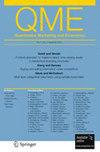Cross channel effects of search engine advertising on brick & mortar retail sales: Meta analysis of large scale field experiments on Google.com
IF 1.1
4区 管理学
Q3 BUSINESS
引用次数: 18
Abstract
We investigate the cross channel effects of search engine advertising on Google.com on sales in brick and mortar retail stores. Obtaining causal and actionable estimates in this context is challenging: Brick and mortar store sales vary widely on a weekly basis; offline media dominate the marketing budget; search advertising and demand are contemporaneously correlated; and estimates have to be credible to overcome agency issues between the online and offline marketing groups. We report on a meta-analysis of a population of 15 independent field experiments, in which 13 well-known U.S. multi-channel retailers spent over $4 Million in incremental search advertising. In test markets category keywords were maintained in positions 1-3 for 76 product categories with no search advertising on these keywords in the control markets. Outcomes measured include sales in the advertised categories, total store sales and Return on Ad Spending. We estimate the average effect of each outcome for this population of experiments using a Hierarchical Bayesian (HB) model. The estimates from the HB model provide causal evidence that increasing search engine advertising on broad keywords on Google.com had a positive effect on sales in brick and mortar stores for the advertised categories for this population of retailers. There also was a positive effect on total store sales. Hence the increase in sales in the advertised categories was incremental to the retailer net of any sales borrowed from non-advertised categories. The total store sales increase was a meaningful improvement compared to the baseline sales growth rates. The average Return on Ad Spend (ROAS) is positive, but does not breakeven on average although several retailers achieved or exceeded break-even based only on brick and mortar sales. We examine the robustness of our findings to alternative assumptions about the data specific to this set of experiments. Our estimates suggest online and offline are linked markets, that media planners should account for the offline effects in the planning and execution of search advertising campaigns, and that these effects should be adjusted by category and retailer. Extensive replication and a unique research protocol ensure that our results are general and credible.搜索引擎广告对实体零售的跨渠道影响——基于Google.com大规模实地实验的Meta分析
我们调查了谷歌网站上搜索引擎广告对实体零售店销售额的跨渠道影响。在这种情况下,获得因果和可操作的估计是具有挑战性的:实体店的销售额每周差异很大;线下媒体在营销预算中占主导地位;搜索广告和需求同时相关;估计必须是可信的,以克服在线和离线营销集团之间的代理问题。我们报告了一项对15个独立现场实验人群的荟萃分析,其中13家美国知名多渠道零售商在增量搜索广告上花费了超过400万美元。在测试市场中,76个产品类别的类别关键字保持在1-3位,而在对照市场中,这些关键字没有搜索广告。衡量的结果包括广告类别的销售额、商店总销售额和广告支出回报率。我们使用层次贝叶斯(HB)模型来估计这一实验群体的每个结果的平均效果。HB模型的估计提供了因果证据,证明谷歌网站上广泛关键词的搜索引擎广告的增加对这类零售商的实体店广告类别的销售额产生了积极影响。这也对商店总销售额产生了积极影响。因此,在扣除从非广告类别借来的任何销售额后,广告类别的销售额增长是零售商的增量。与基线销售增长率相比,商店总销售额的增长是一个有意义的改善。平均广告支出回报率(ROAS)是正的,但平均而言并没有盈亏平衡,尽管一些零售商仅根据实体销售额实现或超过了盈亏平衡。我们检验了我们的发现对这组实验特定数据的替代假设的稳健性。我们的估计表明,线上和线下是相互关联的市场,媒体策划人应该在搜索广告活动的规划和执行中考虑线下效应,这些效应应该根据类别和零售商进行调整。广泛的复制和独特的研究方案确保了我们的结果是通用和可信的。
本文章由计算机程序翻译,如有差异,请以英文原文为准。
求助全文
约1分钟内获得全文
求助全文
来源期刊

Qme-Quantitative Marketing and Economics
Multiple-
CiteScore
2.30
自引率
10.50%
发文量
13
期刊介绍:
Quantitative Marketing and Economics (QME) publishes research in the intersection of Marketing, Economics and Statistics. Our focus is on important applied problems of relevance to marketing using a quantitative approach. We define marketing broadly as the study of the interface between firms, competitors and consumers. This includes but is not limited to consumer preferences, consumer demand and decision-making, strategic interaction of firms, pricing, promotion, targeting, product design/positioning, and channel issues. We embrace a wide variety of research methods including applied economic theory, econometrics and statistical methods. Empirical research using primary, secondary or experimental data is also encouraged. Officially cited as: Quant Mark Econ
 求助内容:
求助内容: 应助结果提醒方式:
应助结果提醒方式:


